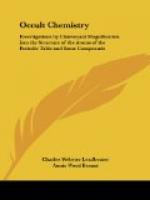V. The Bars.—These characterise a set of closely allied groups, termed “inter-periodic.” Fourteen bars (or seven crossed) radiate from a centre, as in iron (1 on Plate IV), and the members of each group—iron, nickel, cobalt; ruthenium, rhodium, palladium; osmium, iridium, platinum—differ from each other by the weight of each bar, increasing in orderly succession; the details will be given later. Manganese is often grouped with iron, nickel, and cobalt (see Crookes’ lemniscates), but its fourteen protruding bodies repeat the “lithium spike” (proto-element 5) and are grouped round a central ovoid. This would appear to connect it with lithium (2 on Plate IV) rather than with fluorine (3 in Plate IV), with which it is often classed. The “lithium spike” re-appears in potassium and rubidium. These details, again, will come out more clearly later.
VI. The Star.—A flat star, with five interpenetrating tetrahedra in the centre, is the characteristic of neon and its allies (4 on Plate IV) leaving apart helium, which, as may be seen by referring to 3, Plate IV, has an entirely different form.
There are thus six clearly defined forms, typical of classes, with two—lithium and fluorine—of doubtful affinities. It is worthy of notice that in diatomic elements four funnels open on the faces of tetrahedra; in triatomic, six funnels on the faces of cubes; in tetratomic, eight funnels on the faces of octahedra.
Thus we have a regular sequence of the platonic solids, and the question suggests itself, will further evolution develop elements shaped to the dodecahedron and the icosahedron?
* * * * *
II.
We now pass from the consideration of the outer forms of the chemical elements to a study of their internal structure, the arrangement within the element of more or less complicated groups—proto-elements—capable of separate, independent existence; these, once more, may be dissociated into yet simpler groups—hyper-meta-proto-elements—equally capable of separate, independent existence, and resolvable into single ultimate physical atoms, the irreducible substratum of the physical world (see Theosophist, 1908, pp. 354-356).[18]
We shall have to study the general internal structure, and then the breaking up of each element, and the admirable diagrams, patiently worked out by Mr. Jinarajadasa, will make the study comparatively easy to carry on.
The diagrams, of course, can only give a very general idea of the facts they represent; they give groupings and show relations, but much effort of the imagination is needed to transform the two-dimensional diagram into the three-dimensional object. The wise student will try to visualize the figure from the diagram. Thus the two triangles of hydrogen are not in one plane; the circles are spheres, and the atoms within them,




